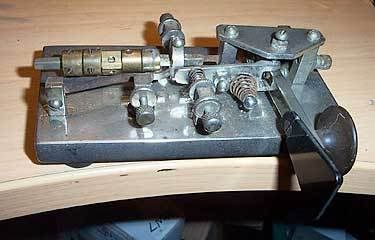I've sworn off buying more semi-automatic keys, right? Well … sort of. Once in a while, something comes your way that's just too darn good to pass up. Or that's my justification for it, anyway.
A fellow was selling several keys in one auction listing recently, and it was a textbook example that prove's “Jim's eBay Rules of Auctioneering No. 4,” which states “Never sell items as a group when there's greater profit selling them individually.” Plain and simple, the seller violated this rule — big time.
As a result, the keys sold for a good deal less than they would have individually. Having a good idea what the group was worth, I sniped them for a great price (at least what I considered 'great.')
The real star among the keys was a hard-to-find Vibroplex World War II Blue Racer DeLuxe. The key is just about mint, and these are difficult to find for sale. The WWII DeLuxe keys are the ones with the special painted base. Chrome was needed for the war effort, so Vibroplex painted the bases on their DeLuxe keys a special grey, a battleship grey. They only did this from 1943-45, and for whatever reason, there were precious few DeLuxe Blue Racers manufactured during this period.
Had the Blue Racer alone been listed correctly, it could have brought as much as the group of keys did.
RIGHT-ANGLE BUG. One of the keys in the group was very unusual — in fact, its the first of its type in my key collection.

This key is a right-angle bug that is constructed much like the Simplex Auto right-angle semi-automatic bugs that were built and sold in Australia. But the key is NOT a Simplex key. I've not been able to identify a maker, nor have I found anything that would absolutely mark the key as a homebrew key.
If this bug is homebrewed, it was built by someone with some exceptional machining skills. Many of the key's parts don't appear to be machined brass or steel, some of them appear to have been stamped, which leads me to suspect it was mass produced.
I don't know the exact vintage of this key, but its construction provides a few clues. Because Vibroplex had the patent on its vibrating keying lever — which was set in motion by movement of the keying lever — other U.S. key makers had to come up with other ways to make a mechanical semi-automatic key.
One of these methods for making dits mechanically relied on the release of tension of the keying lever. The right-angle bug uses this method. The vibrating arm is mounted to a post via a “main spring”, a short section of spring steel similar to that used in the keying arm of a Vibroplex bug. When the right angle bug's keying lever is at rest, the portion that extends to the user's left holds the keying arm against a stop (the adjustment at the middle rear of the key). When they keying lever is moved to the right, the lever moves away from the keying lever, releasing it and allowing it to vibrate.
Using this and similar schemes allowed companies to make their own bug without infringing on Vibroplex's patents — which the company vigorously enforced.
The “tension-release” system works, but its clearly a different animal than a traditional bug keying lever. The main difference is the strength of the vibrations — on the tension-release bug, the vibrations are relatively mild, and it can present a problem trying to get the key to make a string of 4 or more dits.
Because the vibration is weaker, the keying action — pressing the contact to the dit contact post — rapidly dampens the lever's momentum. Thus, the dit contact must be positioned very close to the post, which then makes the dits more rapid and “shallow.” I've had a hard time getting the key to produce H's and 5's. You just don't get the same, solid dits with this type of keying lever that you expect with a Vibroplex.
I've been experimenting with ways to improve the vibrating arm's action. One improvement is to add weight to the arm, specifically the far end. The keying lever now has very small, very light brass weights on it now. I added an alligator clip with some solder wrapped around it, and the extra weight was a big help.
Even after improving the lever movement, the dits are still very “thin.” If you hold to the ideal 3:1 dah-dit ratio, you would need to operate this key at 40 wpm or better! The dits are very, very short.
I'm still investigating my bug, and playing with its adjustments. It appears to be nickel plated rather than chrome, which to me indicates it was probably built prior to World War II.
That's all for this trip. 73 … de KY4Z …. dit dit.
